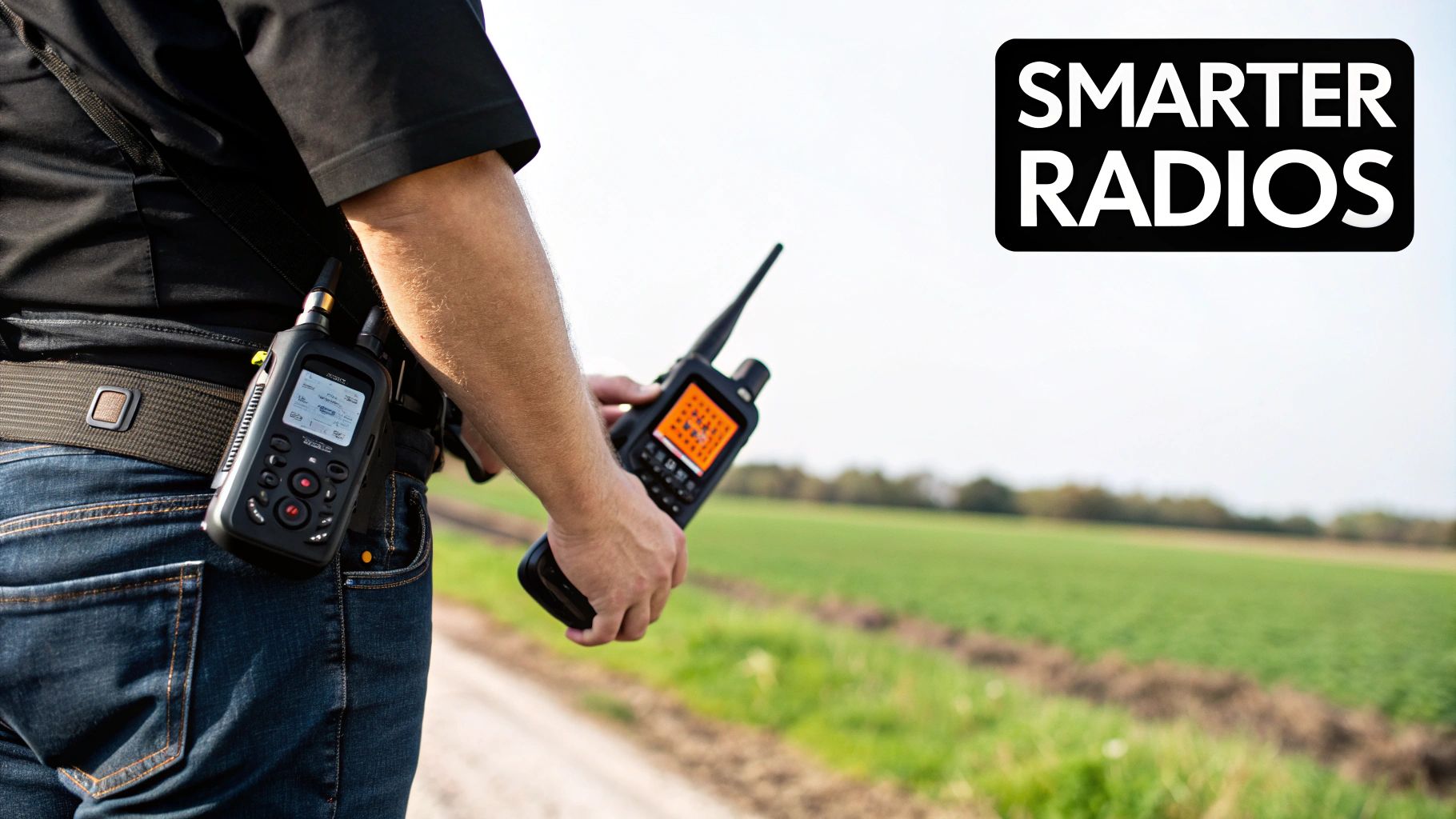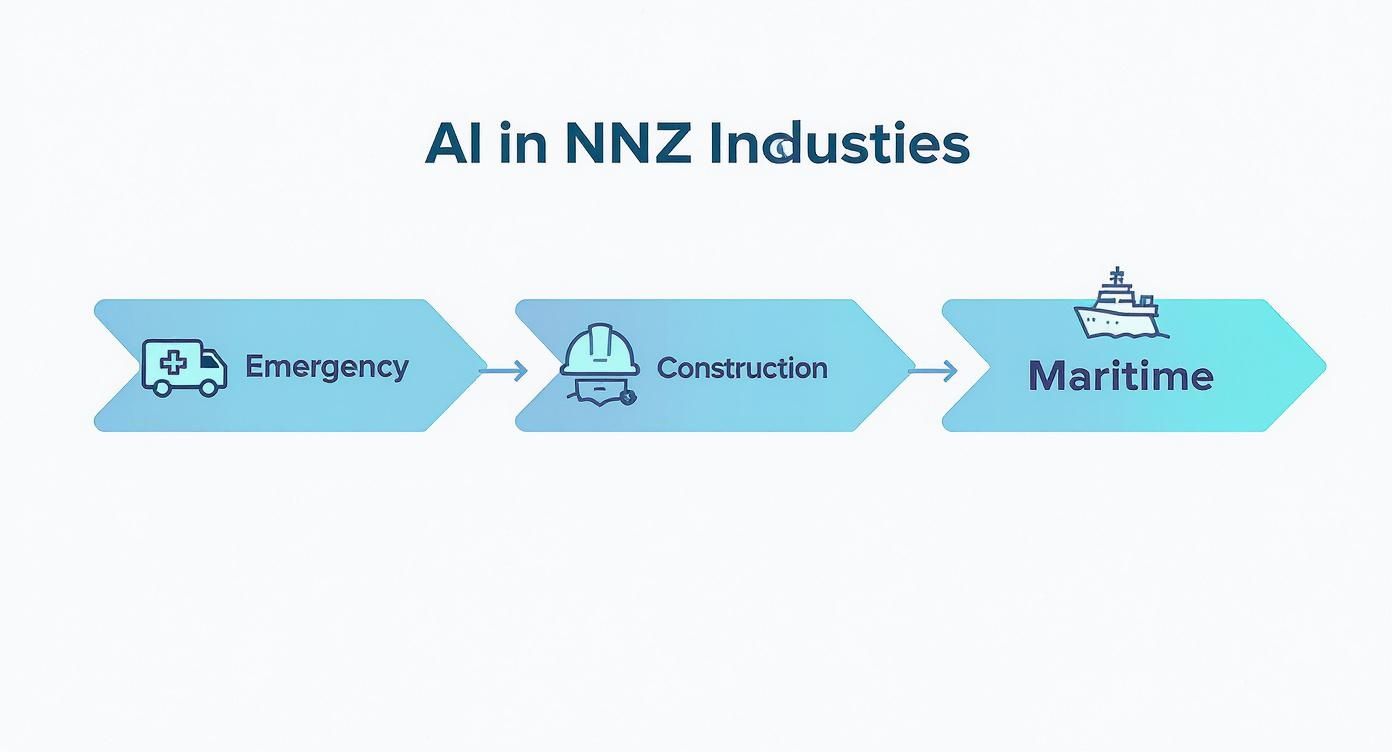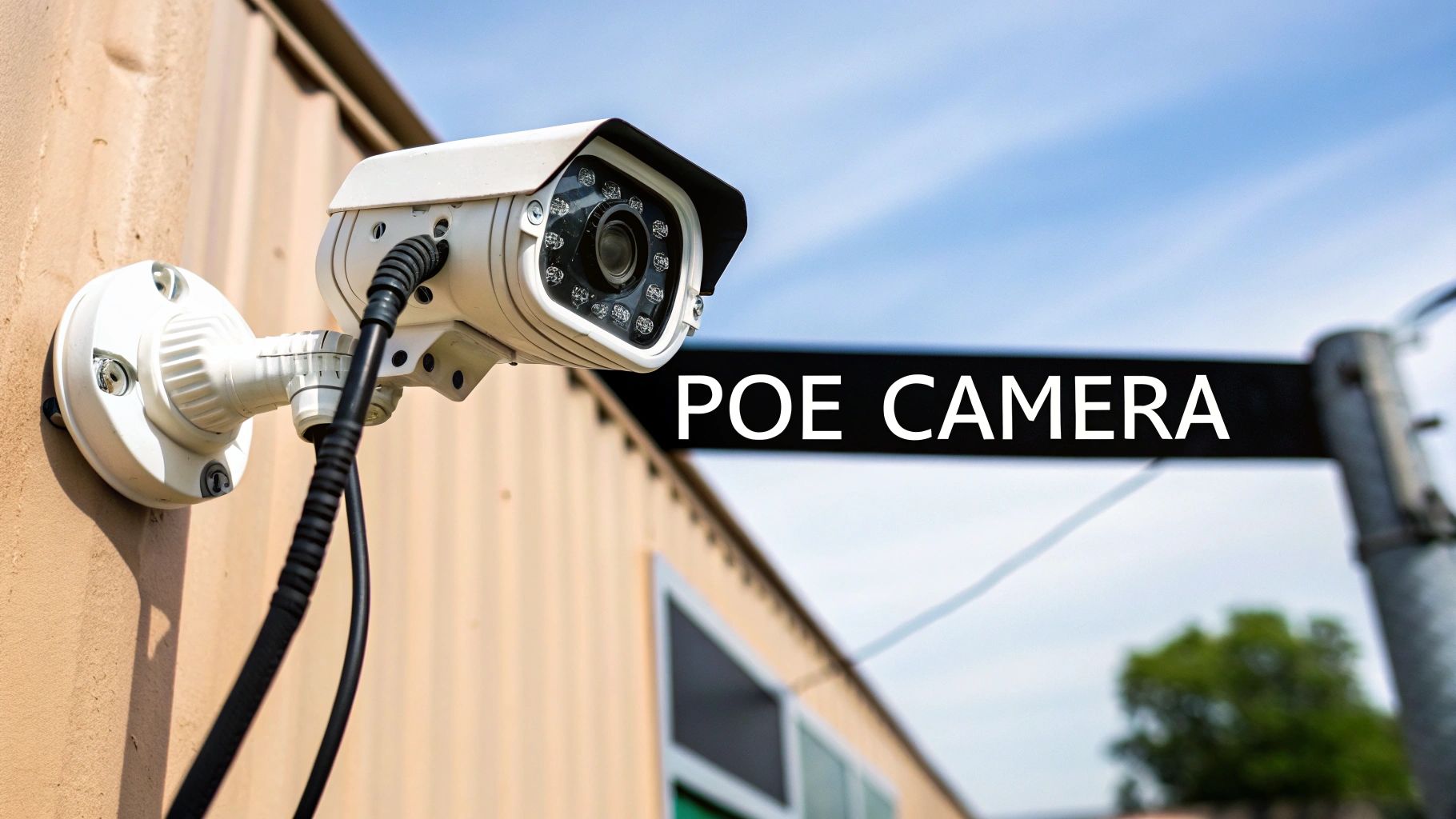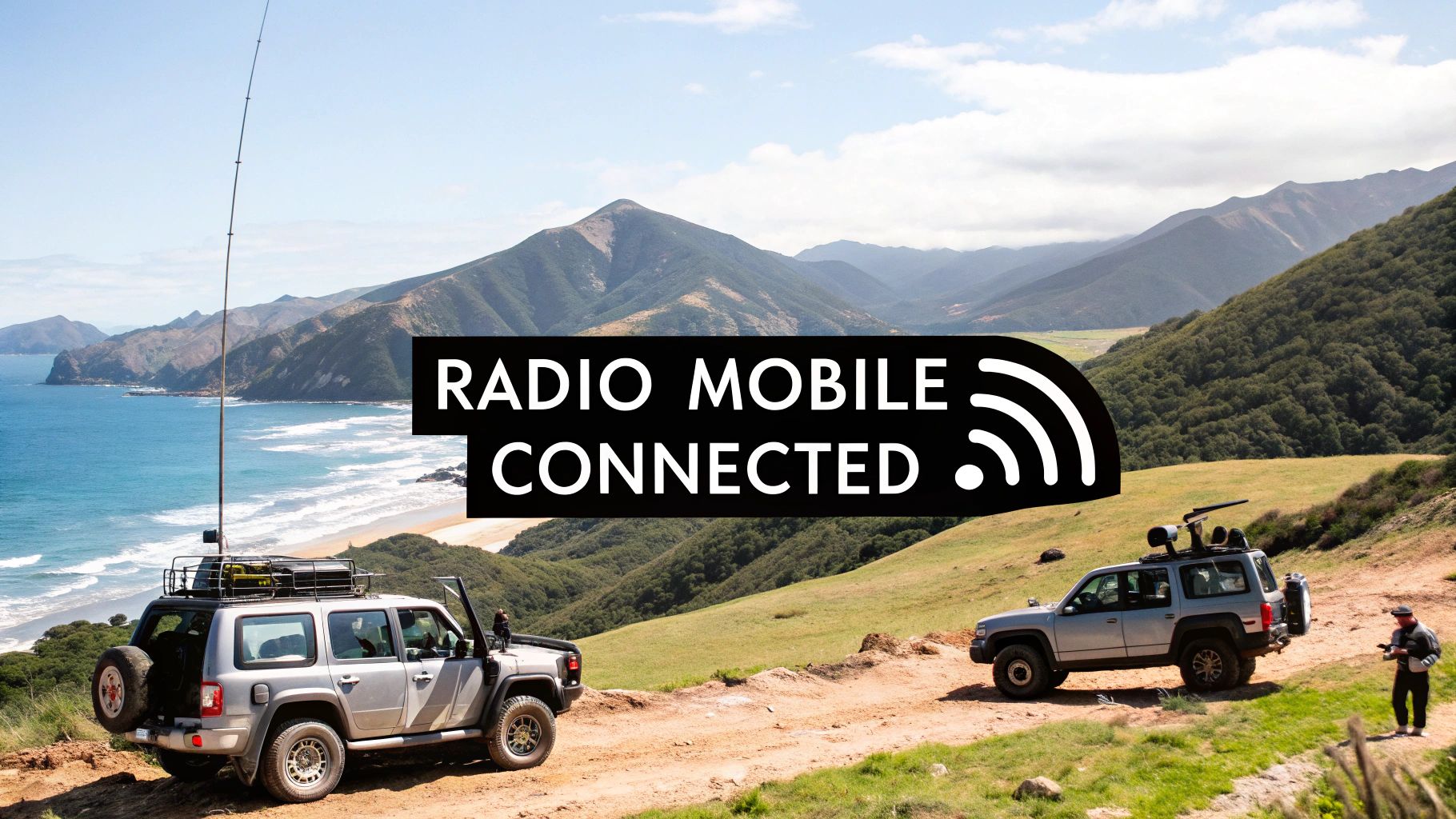How AI-Assisted Communications Solutions Are Future-Proofing NZ Industries
Let's be clear: AI-assisted communication isn't about replacing your gear. It’s about making your existing communication hardware much, much smarter.
Think of it as a powerful digital co-pilot for your team in the field. This isn't some far-off concept; it’s a practical tool available right now that boosts the gear you already trust, whether that's your Motorola two-way radios, Starlink satellite kits, or vehicle GPS tracker systems.
The whole idea is to unlock new capabilities from the equipment your crew relies on every day. It's about adding an intelligent software layer over your hardware to get real, tangible results—like crystal-clear audio on a noisy construction site or slashing response times for emergency services by automatically finding the closest unit.
The Future Is Now: AI-Assisted Communications

So, how does it actually work? These solutions dig into communication data—voice, text, and location—to pull out insights that you can actually use. Instead of just sending a message from point A to point B, the system understands the context of that message. A big part of this magic comes from conversational AI; you can dive deeper into What Is Conversational AI? to see how it works.
This smart layer can handle tasks that were simply impossible before, making your whole operation more efficient and a lot safer. We're talking about giving your team tools that don't just talk; they listen, learn, and actively help out. The combination of AI, IoT, and edge computing is what makes this all possible. We’ve covered this in detail in our guide on the role of AI, IoT, and Edge Computing in modern communications.
The goal here is simple: create a fully connected operation where your team, vehicles, and home base are in constant, intelligent communication. This doesn’t just drive productivity; it seriously reinforces your health and safety protocols across the board.
This shift is already happening right here in Aotearoa. AI-assisted communication is becoming deeply embedded in New Zealand businesses. Specialist providers of legal communication devices are at the forefront, offering expert product knowledge and tailored solutions that ensure organisations are equipped with the right tools for their specific needs, a level of service not typically found in large department stores.
How AI Is Revolutionising Professional Communications

AI is changing the game for professional teams, turning standard push-to-talk communications into something much smarter. It’s not about futuristic concepts; it’s about practical tools that solve real-world problems on the ground, making every interaction over your radio network clearer, faster, and more effective. This is where AI-assisted communications solutions really start to shine.
Think about a construction worker with a Motorola radio on a loud, busy site. In the past, the roar of heavy machinery would obliterate crucial instructions. Today, intelligent noise cancellation can single out the user's voice, making sure every word lands with perfect clarity—a massive leap forward for health and safety.
Or picture a diverse agricultural crew during the chaos of peak harvest. Real-time language translation, built right into their devices, instantly breaks down communication walls. This simple feature ensures everyone is on the same page, dramatically improving coordination and cutting down on mistakes. Tools like these are offering completely new strategies to improve team communication and enhance collaboration in demanding professional environments.
From Voice to Actionable Data
Perhaps the biggest shift is how AI can now turn spoken words into structured, usable data. Voice-to-text transcription means workers can log updates or report incidents completely hands-free, letting them keep their eyes and hands on the job. This isn't just a minor convenience; it fundamentally improves workflow efficiency.
At Mobile Systems, we keep a close watch on these developments, especially from industry leaders like Motorola Solutions. Their work in this space really drives home the practical power of AI in the field.
A brilliant example is their 'Assist' platform, a public safety AI assistant that shows what is now possible. It can translate conversations on the fly, redact faces from body worn camera footage to protect privacy, or even locate a specific vehicle from a simple spoken description. These tools are being deployed today, and as a key partner, Mobile Systems is committed to supporting our customers with these technological advancements.
This technology works best when it acts as a reliable partner in the field. The goal isn't to replace human expertise but to augment it. It can jog a person's memory, verify facts, and ultimately empower your team to make better, faster decisions when it counts.
The Power of Assisted Narrative
The 'Assisted Narrative' feature inside Motorola's 'Assist' platform is a perfect example of how AI-assisted communications solutions boost accuracy and accountability. It's essentially an AI-powered report-writing tool designed to protect a user's firsthand account while backing it up with hard data.
Imagine an emergency responder detailing a complex incident or a technician documenting a repair. Under stress, writing a detailed and accurate report is tough, time-consuming, and prone to human error.
Assisted Narrative completely changes that dynamic. Here’s a look at how it works:
- The officer gives their account first, either by typing or speaking. This makes sure their personal perspective and memory form the core of the report.
- Next, AI cross-references other data sources from the event. This might include radio transcripts from a Tait or Hytera DMR network, audio from an emergency call, GPS tracking data, or body camera footage.
- It highlights any discrepancies for the officer to review, pointing out inconsistencies between their narrative and the recorded facts.
- The system maintains total transparency. 'Transparency notations' clearly show what the AI suggested and which data source it pulled the information from. An audit log also tracks all changes.
This approach saves a huge amount of time, cutting down the back-and-forth between field staff and supervisors over report corrections. It helps build stronger, more defensible reports that hold up under scrutiny, all while keeping the human element—the officer's own words—right at the centre. Here at Mobile Systems, we see this as a massive step forward for any industry in New Zealand that relies on accurate field reporting.
Practical Applications Across New Zealand Industries
The real power of AI-assisted communications solutions truly clicks when you see them in action out in the field. Across New Zealand, from a chaotic construction site to a remote farm, this technology is already making a solid difference. It’s all about taking the rugged, dependable hardware you already trust and making it smarter to solve the unique headaches each industry faces.
For our nation's critical emergency services, every second counts. AI is a genuine game-changer here. Picture an intelligent dispatch system that doesn't just log a call, but instantly crunches real-time GPS tracking data from every vehicle in the fleet. It can then automatically identify and send the closest, best-equipped unit, shaving precious minutes off response times when it matters most.
During a major event like a natural disaster, this same intelligence can sift through mountains of information. It can monitor radio traffic across multiple channels, pick out keywords that signal urgency, and flag crucial updates for command centres. This ensures no vital piece of information gets lost in the noise.
Enhancing Health and Safety in Demanding Environments
In sectors like construction and transport, keeping people safe is priority number one. AI adds a proactive layer of protection for workers, especially when conditions get hazardous.
Think about a lone worker on a massive infrastructure project. A 'man-down' alert from their portable radio can be instantly checked by an AI. The system can access their body worn camera feed to verify a fall and immediately notify supervisors with the worker's exact GPS coordinates. This automatic verification means every single alert gets the serious attention it deserves, without delay.
For transport fleet managers, AI provides powerful tools to stop incidents before they even happen.
- Driver Fatigue Monitoring: In-cab cameras with AI can spot signs of drowsiness, like head nodding or constant yawning, triggering an automated alert to prompt the driver to take a much-needed break.
- Distraction Detection: The system can tell if a driver is on their phone or looking away from the road, creating an opportunity for targeted training and intervention.
- Pedestrian Safety: AI can also act as a second set of eyes around the vehicle, giving audible warnings when pedestrians or cyclists stray into blind spots. We dive deeper into this specific application in our guide on AI Pedestrian Detection Systems.
Optimising Maritime and Agricultural Operations
New Zealand's maritime industry often operates at the mercy of the weather. Here, AI can dramatically improve both safety and efficiency. By blending communications from VHF and Starlink satellite with advanced weather data, an AI system can analyse sea conditions in real-time.
It can then suggest safer, more fuel-efficient routes for vessels, helping them steer clear of dangerous swells or sudden storms. This not only protects the crew and cargo but also trims down operational costs. For recreational boating enthusiasts, this means safer trips and better planning.
The core idea is to create a fully integrated ecosystem. Your Tait DMR radios, satellite communicators, and GPS trackers are no longer just standalone devices. They become data points in an intelligent network that provides actionable insights to keep your people safe and your operations running smoothly.
This isn’t just a future concept; it's happening right now. The Datacom 2025 State of AI Index shows that AI adoption in New Zealand has skyrocketed, with 87% of big organisations now using it. Better yet, 88% of those organisations report positive results, especially in productivity and decision-making. You can check out the AI adoption findings and their impact on NZ businesses for more details. The numbers are clear: Kiwi businesses are already using these tools to get ahead.
Integrating AI with Your Existing Communication Hardware
One of the biggest myths about bringing AI-assisted communications into your operation is that you have to start from scratch. There's a common fear that it means throwing out all the reliable hardware your team already knows and trusts. The good news? That's simply not the case.
Think of these AI solutions less like a complete hardware overhaul and more like a powerful software brain that plugs right into your existing nervous system. This intelligent layer is designed to sit on top of your current infrastructure, giving your trusted Tait or Motorola digital radios, Push-to-Talk over Cellular (PoC) devices, and even your satellite systems a massive upgrade in capability.
The goal isn't to replace your gear, but to create a fully connected ecosystem where your hardware provides the raw intelligence from the field, and the AI turns it into a strategic advantage.
Bridging Hardware and Intelligence
The real magic happens when smart devices on the ground act as a bridge between your team and the central AI engine. A great example of this in action is the Motorola SVX remote speaker microphone (RSM). It’s far more than just a mic; it’s a smart hub that puts AI power right on a user’s shoulder.
With a device like this, an officer can access AI assistants like 'Assist Chat', ask questions, or use voice commands without ever taking their hands off the tools. It’s this kind of practical integration that makes AI a genuine in-the-moment asset, not just some complicated system running in the background.
Suddenly, all your existing gear becomes a rich source of data:
- Two way radios provide crucial voice comms that can be transcribed and analysed for keywords or sentiment.
- Body worn cameras offer vital visual context, which an AI can use to confirm an incident or spot a safety hazard.
- GPS trackers deliver the real-time location data needed for automated dispatch and smarter route planning.
This stream of information is fed into the AI engine, which processes it all and sends back clear, actionable insights to the people who need them most.
The infographic below shows just how these AI-assisted communications are being put to work across key industries here in New Zealand.

As you can see, it's a constant flow of data from the field being transformed into intelligent action, helping boost response times and efficiency where it counts.
Ensuring a Seamless and Future-Proof System
While AI platforms are built to be flexible, a successful integration doesn't happen by accident—it takes careful planning and the right expertise. You need to make sure every single piece of your communications puzzle, from a rugged handheld radio to the cloud-based software, works together flawlessly.
Compatibility is everything. The AI software must be able to properly talk to your specific hardware models and network protocols, whether you’re running a DMR network or relying on cellular. This is where leaning on a specialist provider of legal communication devices makes all the difference.
An expert can take a hard look at your current setup, pinpoint any potential roadblocks, and design a system that’s truly cohesive. They'll also guide you on the underlying network infrastructure, like Radio over IP, which is often the backbone for connecting different radio systems into a single, AI-ready network. To get a better feel for this, check out our guide on the benefits of Radio over IP (RoIP).
By working with specialists, you ensure your investment is not only seamless and compatible but genuinely future-proof. You’re building a system that can evolve alongside your business and adapt to the next wave of technological advancements.
Ultimately, integrating AI-assisted communications solutions is all about getting more value from the hardware you already own. It's about turning your reliable equipment into an intelligent, proactive force that boosts safety, streamlines operations, and gives your team a decisive edge.
Here is the rewritten section, crafted to sound like it was written by an experienced human expert in the field.
Can We Trust AI With Our Data? A Look at Privacy in New Zealand
As businesses across New Zealand start exploring what AI-assisted communications solutions can do for them, one of the first questions is always about data privacy. It's a fair question. When you adopt powerful new technology, you take on the responsibility of handling information securely and ethically.
The good news is that professional-grade systems are built with these concerns front and centre. Security, transparency, and accountability aren't afterthoughts; they're baked in from the very beginning.
The conversation around AI is definitely heating up. New Zealand's own AI strategy, which kicked off in early 2025, aims to get more Kiwi businesses on board while setting clear, responsible guidelines. While 67% of our large firms are already using AI, a huge 68% of small and medium businesses are still on the fence, mostly worried about complexity and security. You can get more detail on New Zealand's strategic approach to Artificial Intelligence here.
This gap shows just how important it is to have trusted, secure platforms built for professional use, not just for consumers.
Your Data Stays Your Data: The Power of Secure AI Models
It's crucial to understand that not all AI is built the same way. The consumer-grade tools many of us have played with often pull from public data and simply don't have the security needed for sensitive operational information.
Professional solutions, like Motorola's 'Assist Chat', are a different beast entirely. They are built on private, secure models designed to meet the tough standards of public safety organisations.
This means your critical operational data—everything from radio transcripts to GPS tracking logs—is handled in a completely closed-off environment. The AI is trained for a specific job and never shares your information with public models or anyone else.
The core idea is simple: your data is there to help your operation, and that's it. This commitment to a secure, private AI is what builds the trust needed for industries where mistakes aren't an option.
This isn't just a "nice to have"; it's essential for any organisation dealing with confidential information, whether for health and safety records, commercially sensitive plans, or personal privacy.
Knowing Where Your Data Is and What It's Doing
Having your data locked down is one thing, but knowing exactly where it is and how it’s being used is just as important. This is where the concepts of data sovereignty and transparency come into play.
Data sovereignty is all about maintaining control, including deciding where your data is physically stored. For many New Zealand organisations, keeping data within our borders is a non-negotiable for compliance and simple peace of mind.
Transparency is about peeling back the curtain on how the AI works. You need to know how it arrives at its suggestions. The best platforms now have features that make this process crystal clear.
- Transparency Notations: Think of these as footnotes for AI. They are clear markers in a report that show exactly what the AI suggested and where that information came from—whether it was a body worn camera clip or a radio transmission log.
- Audit Logs: This is a complete, unchangeable history of a document. It tracks every version from the first draft to the final copy, showing every change and clearly marking whether it was made by a person or suggested by AI.
These aren't just technical specs; they are tools that build trust. They create a clear line of accountability, making sure a human is always in the driver's seat, fully aware of how the technology is helping them. By focusing on secure models, data sovereignty, and total transparency, modern AI-assisted communications solutions give businesses the confidence they need to get connected and stay ahead of the curve.
Partnering with Mobile Systems for Your AI Journey
Making the leap to AI-assisted communications solutions can feel like a huge step, but you don't have to figure it all out on your own. This isn't just another tech upgrade; it’s a fundamental shift in how your business operates—improving worker safety, making reporting easier, and ultimately helping to future-proof your entire operation.
At Mobile Systems, we get that this journey is about more than just plugging in new gear. It’s about giving your team the tools they need to be safer and more effective, making your business sharper and more competitive. We're not just box-movers; we are specialists who live and breathe the legal communication devices and hardware that your operations depend on.
Your Expert Partner in AI Integration
Our team has deep, hands-on knowledge of the industry's most trusted brands, including heavyweights like Motorola Solutions, Tait, and Hytera. Unlike a generalist retailer, our focus is squarely on professional communication equipment. We know how this gear holds up in the tough conditions New Zealand industries throw at it every single day.
We work with you as a partner, crafting a strategy that fits your business like a glove. The best solutions are never one-size-fits-all.
Adopting this technology is a journey we navigate together. Our goal is to ensure your team stays fully connected, safe, and efficient, giving you a clear advantage in a demanding market.
A Clear Path Forward
Getting started is simpler than you might think. We've designed our process to give you clarity and confidence every step of the way.
- Consultation and Assessment: It all starts with a conversation. We’ll sit down with you to understand your current setup, your daily operational headaches, and what you’re hoping to achieve.
- Opportunity Identification: Our team will then take a close look at your existing hardware. We pinpoint the most impactful ways to bring in AI, ensuring you get the best possible return on your investment.
- Bespoke Solution Design: Finally, we’ll design a complete, tailored solution that meets your specific needs—whether that means boosting your existing radio network or integrating new camera and tracking capabilities.
The world of communication technology is moving fast. Partnering with a specialist ensures you not only keep up but get ahead of the curve.
Ready to explore how AI-assisted communications solutions can support your business? Contact the Mobile Systems team today for a no-obligation chat. Let's start the conversation and build a smarter, safer future for your operation.
Your Questions Answered
When businesses in New Zealand start looking into AI-assisted communications, a lot of practical questions pop up. Getting your head around how it all fits together—implementation, compatibility, and training—is the key to making the right call for your operation. Here are some of the most common queries we field from our clients.
Will AI Work with My Older Radio Systems?
This is easily one of the most common—and important—questions we get. The great news is you often don’t need to ditch your entire fleet of trusted Tait or Motorola radios. Modern AI solutions are built on software, designed to plug into existing digital communication platforms like DMR.
While very old analogue-only systems can be tricky, any reasonably current digital radio network can almost certainly be the backbone for an AI upgrade. It all comes down to how data, like voice and GPS location, is being transmitted. We can take a look at your current gear to see what’s possible and map out the smartest way forward.
What Kind of Training Is Needed for My Team?
Getting your team on board is everything, and the best AI-assisted communications solutions are designed to be second nature. The whole point is to make a field worker's job easier, not to add another layer of complexity.
For the crew on the ground using features like voice-to-text or intelligent noise cancellation on a handheld device, the training is usually pretty minimal. It’s often just a case of learning a few new voice commands or button functions.
For managers or dispatchers who’ll be using the analytics dashboards, the training is a bit more involved. This usually covers how to make sense of predictive alerts, read AI-generated reports, and use the system to tighten up team coordination and health and safety monitoring.
How Much Does It All Cost?
There’s no one-size-fits-all price tag; the cost really hinges on your specific needs and what you’re already working with. The investment typically breaks down into a few main areas:
- Software Licensing: This is usually a subscription fee, which can change based on how many users you have or the specific AI features you want to unlock.
- Integration Services: This covers the work to get the AI software talking to your existing radio network, CCTV cameras, or other hardware.
- Hardware Upgrades: You might need some new bits of kit, like a server or specific Motorola radio models that have AI capabilities built-in, but a complete overhaul is rare.
It’s much more helpful to think of it as an investment rather than a cost. Once you calculate the potential return from better efficiency, fewer incidents, and less time spent on reporting, the value becomes crystal clear.
We always suggest a proper consultation to work out a precise quote that’s built around your operational goals and budget. This way, you only pay for the tools that will genuinely move the needle for your business.
At Mobile Systems Limited, we specialise in designing and implementing communication systems that are powerful, reliable, and ready for whatever comes next.
Contact our expert team today to discuss how AI-assisted solutions can be tailored for your New Zealand operation.

